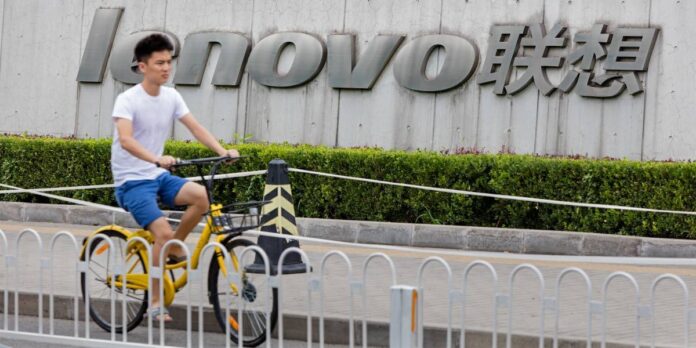B&F caught up with Marco Pozzoni, EMEA Storage Sales Director for Lenovo’s Infrastructure Solutions Group, about Lenovo’s moves in the storage sector. He was hired from NetApp, where he was MD for Italy, in 2020.
China’s Lenovo is a Hong Kong-headquartered PC and IT systems supplier that focuses on mainstream IT markets. It is a giant business, and revenues in its fiscal 2023 year were $62 billion.

The PC and server product lines are based on its acquisitions of IBM’s PC and server business units in 2005 and 2014 respectively. Kirk Skaugen is the EVP and president for Lenovo’s Infrastructure Solutions Group (ISG) which supplies its server, storage and networking products. He was a PC guy, being an ex-Intel SVP and GM of its Client Computing Group, joining Lenovo in 2016. Pozzoni was hired from NetApp, where he was MD for Italy, in 2020, and was part of the Lenovo team that subsequently set up the partnership with NetApp.
Our impression is that a core Lenovo focus has been on selling hardware-based systems, which it is now also supplying through its TruScale IaaS deal. Lenovo is not known for developing chip-level products, like Huawei, nor for developing its own software – witness the OEM deal with NetApp and the reselling deal with Weka. It is a formidable IT hardware manufacturer and system supplier and, with its channel, a determined supplier to emerging or enlarging markets, such as the current AI market.
In August the ISG unit reported $1.9 billion in revenues in Lenovo’s first fy2024 quarter. It said it experienced hyper-growth in storage, software, services, and high-performance computing (HPC), with storage achieving triple-digit year-on-year growth, making Lenovo the 4th largest storage provider in the world.
In particular and according to IDC (Q1 CY23):
- Lenovo is in #4 position WW on AFA Total Storage (Dell, NetApp, Pure and Lenovo)
- Lenovo is in #2 position WW looking at AFA Price Bands 1-6 ($0-100k) (Dell, Lenovo, Pure and HPE)
- Lenovo is in #1 position WW and EMEA looking at AFA entry Price Bands 1-4 ($0-25k)
Pozzoni told us: “It is worth noting that today’s market is characterized by All Flash, Hybrid and HDDs Arrays. In Q1 CY23, according to IDC, All Flash Array was accounting for 45 percent of the entire arrays [market]. Whereas for Lenovo, it is actually 61 percent. This shows the great investment Lenovo is making in innovative technologies like AFA to help customers in their digital transformation journey.”
He said: “Kirk had this vision of becoming the number one infrastructure player from a storage perspective, and worldwide level.” The company is making progress, Pozzoni claimed: “Eight years ago, we were number 11, from a total market share perspective around storage, according to IDC. We are today number four… Over a span of eight years, being able to move from number 11 to number four, is a massive achievement.”
“We’re not number three yet, we’re not yet on the podium, but we are getting close.”
What will it take for Lenovo to overtake HPE ($1.1 billion in its latest quarterly storage revenues) and become number 2 behind NetApp, with its most recent $1.43 billion quarterly storage revenues? Pure’s latest quarterly revenues totalled $688.7 million, so we can say Lenovo’s current quarterly storage revenues are more than Pure’s $688.7 million but not as much as HPE’s $1.1 billion.
Lenovo’s storage product line
This consists of:
- Unified storage products
- DG series all-flash arrays (AFA) using QLC flash and NetApp’s ONTAP software
- DM series AFA, with TLC flash, and hybrid SSD/HDD arrays, using ONTAP
- SAN products – DE series AFA and hybrid arrays, FC and IP SAN switches
- Direct-attached storage – Various JBODs
- Hyper-converged Infrastructure – ThinkAgile server-based – VX – VMware, HX – Nutanix, SX – Azure Stack
- Tape – IBM TS22nn and 43nn tape drives and autoloaders
Lenovo OEM’s NetApp’s ONTAP unified file and block access storage operating system and ports it to its own hardware. Pozzoni said Lenovo has a joint-venture with NetApp in China, 51 percent owned by Lenovo and 40 percent by NetApp. Lenovo sells its products with perpetual licenses or makes them available through its TruScale pay-as-you-go, IaaS subscription service.
There are no monolithic arrays, similar to Dell’s PowerMax or IBM’s DS8000, and neither are there scale-out, parallel filers such as those like Dell’s PowerScale (Isilon) and Qumulo, in Lenovo’s storage product line. But Lenovo is partnering Weka to resell its file services software integrated with ThinkSystem servers into the high performance AI and analytics markets.
HPE is OEM’ing VAST Data’s scale-out and disaggregated file storage software and aiming at the same markets. Its quarterly storage revenues have been hovering between$1.1 billion and $1.3 billion since 2018. If Lenovo can continue racking up storage growth at a 3-digit Y/Y clip then it could overtake HPE’s storage revenues in a year’s time.








